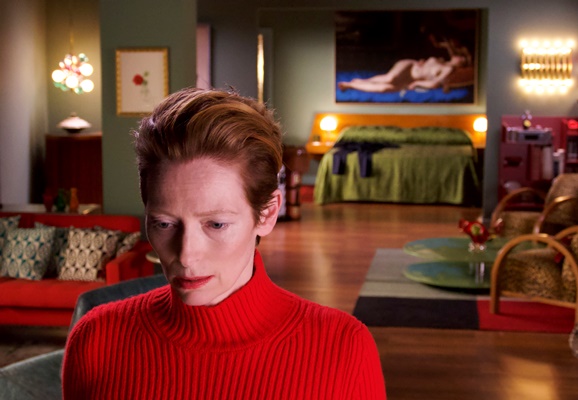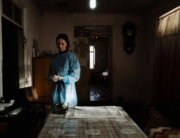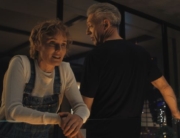Pedro Almodóvar’s 31-minute Western-cum-queer-love-story made its North American debut at the Toronto International Film Festival, before it headed Stateside to the New York Film Festival. In both cases, a conversation with the filmmaker followed the screening—you’ve got to give the people something more. Sony Pictures Classics will release this star-driven project, along with Almodóvar’s 2000 short film, The Human Voice, this fall in a double-bill that runs for the grand total of 61 minutes. The new work will aptly screen first; it feels like an opening to a longer saga. Though its compact storyline crams in a lot of revelations, twists, and turns, it nevertheless feels incomplete, like the opening chapter of a book with the other pages torn out.
Set circa 1910, Silva (Pedro Pascal) rides his horse into the dusty town of Bitter Creek, which presumably lies near the Mexican border, and heads straight toward the sheriff’s office. There he sets his eyes on the by-the-book lawman Jake (Ethan Hawke) for the first time in 25 years. After decades apart, the skeptical and nonplussed Jake wonders why Silva has returned. After a night of drinking in which both men allow the booze to do the talking, Jake has his answer: The morning after, a nude Silva lies in Jake’s bed. Jake brusquely pretends as though nothing has happened, even as the men make the rumpled bed together. But while going through Jake’s drawers searching for clean underwear, Silva finds a memento he gave Jake long ago.
What follows is a lot of rough and tumble, though not in the bed, that is left off screen, but out in the dirt. In addition to the reawakening of mid-life lust, the killer of Jake’s sister-in-law is on the loose, while a fight scene between the two squabbling lovers qualifies as Almodóvar’s first action sequence. (The short was filmed on the set of Sergio Leone’s “Dollars” spaghetti Western trilogy of the 1960s.) Because there is a lot of story for such a short length of time, the result feels rushed and too to the point. It concludes right when it starts to pick up steam—and not the hot and heavy kind. Some of the dialogue also calls to mind another new genre for Almodóvar, the romance novel. Pascal is saddled with heart-on-his sleeve, florid dialogue when he describes the weary men’s still-hot attraction for each other as, “Ours is a strange fate” or “It was destiny, and we can’t fight it.”
The story feels more like an appetizer leading to the main course, which is the case here, given that it precedes The Human Voice, Almodóvar’s first English language film, that was made and distributed during the pandemic. This reissue may be the first opportunity for viewers to see it on the big screen. Like Strange Way of Life, it has a fleet running time of 30 minutes, yet it feels like a full meal, and the real deal. That’s no surprise, given that the source material, written by Jean Cocteau, has been the inspiration for three film versions, plus Poulenc’s opera, La Voix Humaine. Below is the review for its online screening during the 2020 pandemic New York Film Festival.
For the last 21 years, the New York Film Festival has presented all but one of Spanish director Pedro Almodóvar’s feature films, and he last appeared at the NYFF with Pain and Glory in 2019. This year is no exception, although like all of its programming and post-screening Q&As, the event will not be in-person, but online. Filmed just a few months ago and fresh from its premiere at the Venice Film Festival, The Human Voice becomes the filmmaker’s eighth film screened at the annual autumnal festival since All About My Mother.
In only 30 minutes, Almodóvar’s elegant take on Jean Cocteau’s 1930 one-act/one-woman meltdown packs more drama than many movies four times its length. Working for the first time in English, the director “freely,” as the credits say, adapts the play as a showcase for Tilda Swinton, who follows in the formidable footsteps of Anna Magnani in Roberto Rossellini’s claustrophobic version in the L’Amore anthology (1948) and more recently Sophia Loren in son Edoardo Ponti’s Human Voice from 2014, in which the star gives one of her most raw and well-defined performances. (Both versions are currently streaming on the Criterion Channel.)
From the color-coordinated sets—dominated by blues, reds, and greens—and the melancholic slow waltz by composer and Almodóvar regular Alberto Iglesias, the viewer knows immediately who’s in charge. Yet the filmmaker remains faithful to the playwright, in his own fashion, with the story tweaked for a modern-day setting and not succumbing to a pity party.
Over the telephone, an unnamed woman confronts the man who has dumped her for good three days earlier and moved out and on. She knows from the first ring she will never see him again and that this will be their last contact and presumably her last great love. Almodóvar signals the artifice of the production right away by exposing the film’s set within a cavernous soundstage. When Swinton makes her diva-like entrance, she walks across the soundstage like a somnambulist, dressed in a scarlet red bell-shaped ball gown. Yet it doesn’t matter that we know this is only a movie; what follows is convincing and absorbing.
Although the stage is set for a high-gloss melodrama, Swinton’s performance is more low-key and conversational than the previous film versions. Its tone is less Carmen Maura in the director’s 1980s work such as Law of Desire but more internalized—think Antonio Banderas from last year’s Pain and Glory. Although the lover’s voice is never heard, you would swear that you can hear his dialogue because of Swinton’s focus and spontaneity. The actress has a technological advantage that Magnani or Loren did not have: freedom of movement thanks to Bluetooth. (Loren’s version is set in 1950 Naples in the days of the party line.)
In perhaps the most crucial change from the other interpretations, there’s more anger and resignation here. Those familiar with Cocteau may be left waiting for a full-on operatic breakdown—for that, go to Magnani. The dialogue still builds to a confrontation as the woman drops her calm, nonchalant façade and lets the man know how she really feels. Still, Swinton holds back a bit, though still threatening to explode at any moment. The director and the actress offer a taste of the distraught woman’s rancor and bitterness, playfully leading us on and leaving us wanting more.
Though the source material is 90 years old, this is no retro exercise or an occasion to wallow in misery or victimhood. (Come to think of it, Lionel Bart’s “As Long as He Needs Me” torch song would suit this material perfectly.) Unlike her onscreen forebears, Swinton’s jilted character has options they did not have, and Almodóvar imagines what happens to his heroine after she hangs up the phone for the last time. Both the play and all three film adaptations capture a moment in time, but Almodóvar hints at the woman’s future and ends the drama on a hopeful note. If nothing else, the eye-opening, vibrant color design of her apartment is vibrant enough that it could take on the form of Xanax, if she ever decides to seek relief from depression.
Strange of Way of Life/The Human Voice will be released together in the United States on October 6.








Leave A Comment